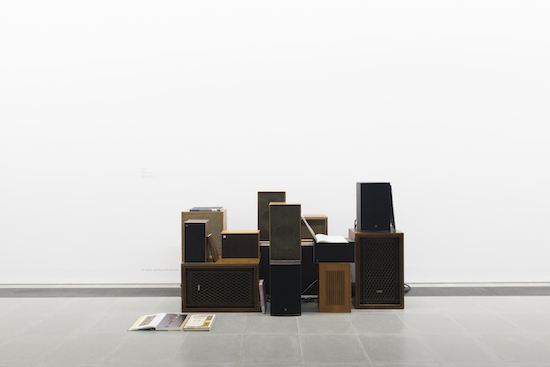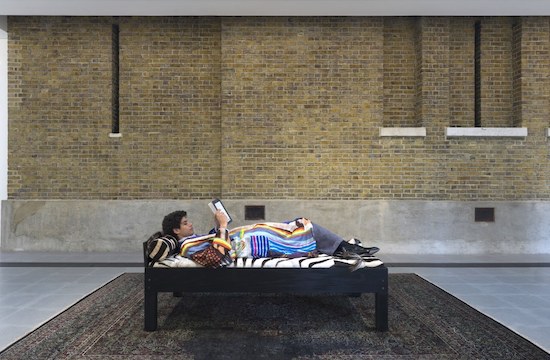Rashid Johnson, Untitled (daybed 1) 2012, Grace Wales Bonner: A Time for New Dreams. (Installation view, 18 January – 16 February 2019, Serpentine Galleries). © 2019
In Grace Wales Bonner’s first major exhibition titled A Time for New Dreams, also the first exhibition at the Serpentine Sackler to be created by a fashion designer, the 28-year old British polymath seeks to blur the lines between the intellectual and the spiritual, to show that they are not each other’s antithesis.
The scholarly approach to artistic creation comes naturally to Wales Bonner who is well-known for a design process that collates musical, literary, and visual sources. What is interesting about this exhibition however is the way the research hasn’t been subsumed or transformed into something new that alludes to the wealth of sources from which Wales Bonner draws inspiration. Instead, all the threads of investigation are laid bare and the result is a collage of reference points that take the form of shrines.
Wales Bonner’s Shrine I (2019) embodies this homage to research. The wooden sideboard unit with a vintage television sitting on it evokes a comfortable homeliness rather than the aloofness of academia. Books rest on its surface – “altar objects” – and are visible through the door of the unit left ajar. There is a copy of exhibition collaborator Nigerian poet and novelist Ben Okri’s An African Elegy. The looped installation on the TV at one point shows novelist Ishmael Reed, another of Wales Bonner’s collaborators, at the Brockport Writers Forum. The piece is a clever nod to the etymology of “shrine” which comes from the Latin word for a chest of books: intellectualism and spirituality in one glance.
The transparency of influences and the inclusion of these artists, writers, and musicians’ work in the exhibition make it feel much more like a group show that Wales Bonner has curated. In fact the show’s title comes from the eponymous essay collection by Nigerian poet and novelist Ben Okri and Ishmael Reed’s 1972 satire Mumbo Jumbo provides the title for Wales Bonner’s upcoming Autumn/Winter 2019 collection.
Okri provides invocations for the shrines which are written on several walls around the gallery and can also be heard through speakers. The poems are full of the spiritual and the tautological such as “The world is the shrine / And the shrine is the world” and call upon the reader with urgency (“Awake! Awake! Awake!”) to help shape a new reality through a new kind of dreaming. The invocation is a command to create magic through ritual, a theme that permeates the show.

Grace Wales Bonner, Shrine II 2019, Grace Wales Bonner: A Time for New Dreams, 18 January – 16 February 2019, Serpentine Galleries, © 2019
American conceptual artist Rashid Johnson’s daybeds Untitled (daybed 1) and Untitled (daybed 6) are made of branded red oak and zebra skin. Each has several tufts sticking up, alluding to a tail, making the beds look like creatures suspended in the middle of transformation. Johnson describes his method as “hijack[ing] the domestic”. It is a kind of spell, where the act of creating art seems to imbue an otherwise ordinary object with a strange kind of partial sentience.
Money Tree (1992), created by American artist David Hammons, who once said, “Outrageously magical things happen when you mess around with a symbol”, does this too. The photographic print depicts a lone and barren tree in a yard, a limp ring jutting out of the trunk: it’s a makeshift basketball hoop. Money Tree, like several works by Hammond, explores the promise of basketball as one of the routes out of poverty for young black men in America. The photo’s sepia tone imparts to the tree the aura and gravitas of the mythic, alluding to all the hopes and dreams invested in the sport. But this effect also ironizes the object, and animates it with a knowingness that seems to say to the observer that it is, as the exhibition’s title suggests, time for new dreams.
In several interviews Wales Bonner mentions a predilection for hybridity. The exhibition conveys a strange hybridity in its atmosphere, one simultaneously of urgency – embodied primarily in the invocations of Okri – and also of deep reflection and stillness. It made me realise the exhibition’s title is A Time for New Dreams, leaving open the possibility that that time is not necessarily now. Instead, what needs to happen right now is intense preparation, in other words, research, which consists of soul searching and the asking of ancestors both artistic and spiritual for courage and guidance.
R. F. Thompson who wrote the book which inspired Wales Bonner’s thinking on shrines, Face of the Gods, is quoted in the show’s accompanying zine: “Change, infused with spirit, generates extremely powerful iconic histories.” It feels like a big ask in these times, to create new dreams from a place of stillness, especially when exhibits like Kapwani Kiwanga’s Flowers for Africa (2014–2015) which are floral arrangements left in the gallery to wilt, suggest that time is running out. Shrines, after all, honour the dead and the absent.
This could account for the frustrating sense of reticence that is present in the exhibition too. The research-as-art and inclusion of a total fifteen artists and collaborators seems to obfuscate the actual – and presumably powerful – effect of the research on Wales Bonner herself. One could see it as a refreshing and appropriately spiritual shedding of the ego that the exhibition sends the viewer more directly to the work of others. Following these threads of research then, can potentially take you on a voyage of discovery similar to the artist’s: a kind of hero’s journey at the end of which may be the capacity to dream anew.
Grace Wales Bonner, A Time for New Dreams, is at the Serpentine Sackler Gallery until 16th February 2019


